Puma Deviate Nitro 2 Review: The Big Cat’s Pajamas
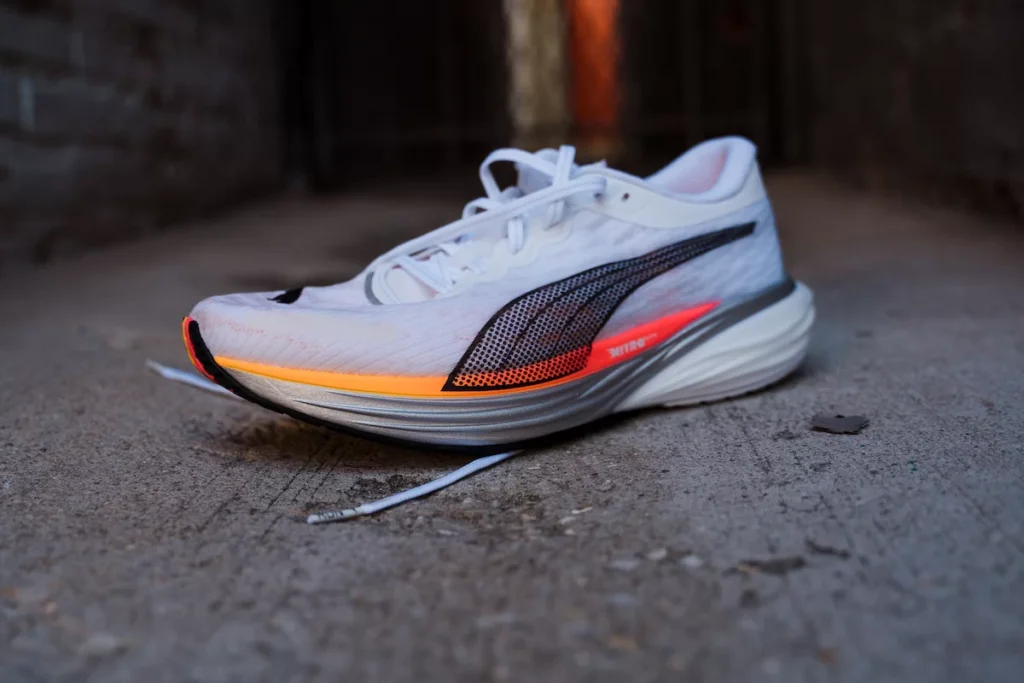
INTRO THOMAS: Puma went hard last year, dropping an entire lineup of trainers. We were pretty well impressed across the board. There was room for improvement, but the Deviate Nitro was a hit for almost everyone. However, for us, the heel counter kept it in the good but not great category. If you didn’t deal with heel lift, maybe you wound up with a blister from the lack of padding. Puma’s Nitro foam with a carbon-infused plate offered a nice cushioned ride, but it wasn’t as responsive as we hoped for. But, as this was the first good Puma running shoe in years, we were just excited to see them back in the game. Even then, we weren’t sure how committed Puma was to the running segment. So we held our breath waiting for the next round. Supply chain issues rocked the joint in 2021 and 2022, and Puma was hit pretty hard. So, as a result, we’ve only seen four releases for the year: Fast-R, Velocity Nitro 2, the female-specific XX Nitro WMS, and the Puma Deviate Nitro 2. We’re happy to report that both updated shoes improved over the originals. BRANDON: I’m not even gonna wait for the end. Puma knocked this one out of the park. Seriously. This might be one of my favorite daily trainers this year. I never wore the previous model of the Puma Deviate Nitro, but the second version comes with all of the goods. Puma has added a layer of Nitro Elite foam, which has this shoe on a new level of awesome. Let’s dive in so I can tell you what’s good. MEAGHAN: The Puma Deviate Nitro 2 showed up with a full layer of Nitro Elite Foam, a reworked Pwrplate, and extra padding around the collar and heel. I guess you could say they made some pretty great improvements. Let’s dive into the details. THE GOOD THOMAS: Kudos to Puma for listening to the feedback from runners. They ditched the awkward and ineffective heel counter and replaced it with a more traditional padded collar. All that matters is it works well. There’s no more heel lift or irritation. The upper is quite elegant with thinner open mesh over the toes and tighter weave where the shoe needs structure. A strip of PWRTAPE on the medial side near the arch keeps things light but still solid. The lightly padded tongue disappears and wraps the saddle with a thin gusset. As you can guess, I had zero issues with the upper. The Puma Deviate Nitro 2 fits true to size, breathes, and has no hot spots. Even the laces offer nothing to complain about. The Nitro foams have been well received. I didn’t have an issue with the regular Nitro in the previous model. But Puma made the foams in the Deviate Nitro 2 even better. They added a full-length layer of Nitro Elite, which is softer and returns more energy than the standard Nitro. On its own, the Nitro Elite might feel too soft, but Puma added another layer of Nitro (regular) in the heel. There’s a carbon composite Pwrplate sandwiched between the two, which does two things. First, it helps propel the energy from toe-off forward. Additionally, the plate adds stability to the platform. As always, the base of the Deviate Nitro 2 is a Pumagrip outsole. Their rubber is one of our favorites in the industry, and they told us that this formula is even better. I don’t know the difference, so I’ll take their word for it. It still seems to kick ass. BRANDON: I had pretty low expectations going into this review. Puma shoes have always been good, but not great. This one really lands that “great” factor for me. The Deviate’s addition of Nitro Elite foam gives it the cushioning and springy feeling I love in a running shoe. The carbon-infused plate provides enough stability and pop off the toe to enable a smooth but fast ride when I need to pick up the pace. This daily trainer is light, versatile, smooth enough for long run days, and fast enough for tempo days. I thought the upper was comfortable, with a strong lockdown in the midfoot with a gusseted and thin tongue. Moving to the bottom of the shoe, Puma Grip is one of the best in the biz. The grip provides enough durability for the shoe to last over 400 miles and still provide tacky traction even on the slickest terrains. I was impressed with how well I could corner in the shoe. MEAGHAN: The guys covered most of the details, so I’ll keep this short. The step-in feel is great, the shoe is true to size, and it accommodates my wide feet well. The additional padding around the heel and collar is a welcomed update, and I had no issues with heel slippage or hot spots. The Nitro Elite foam elevates this iteration and, paired with the Pwrplate, provides a fun pop. It took me a couple of runs to really love this shoe, but now I find myself lacing them up on back-to-back days. As if you don’t already know, the Puma Grip outsole remains a favorite. It’s the grippiest stuff out there. THE BAD THOMAS: Puma fixed all of my complaints about the original. I wish I had something to say to improve the next one, but this shoe is a damn fine daily trainer. On the first run, the toebox seemed like it might be a little tight, but it either stretched out or loosening the laces did the trick. BRANDON: It’s hard to talk about the negatives of this shoe. Honestly, I have to dig and search for negatives. For $160, it’s not cheap, I guess? But it’s by no means that expensive, either. I believe that Puma missed an opportunity to price the shoe at $130 or $140, which would have made it a tough shoe to pass up. MEAGHAN: Much like the guys, I couldn’t find much to complain about here. That said, Puma is calling this their max
The Best Tracksmith Apparel for Fall 2022
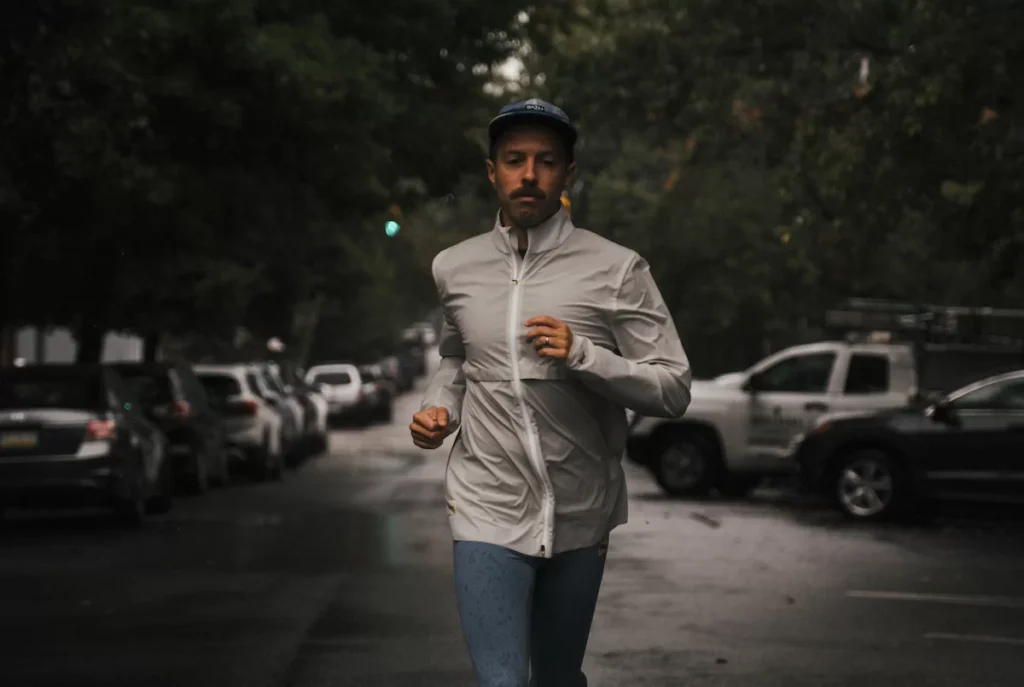
INTRO You can call us basic (mostly Wide Foot Jarrett and his pumpkin-ass self), but we love fall. We’re not talkin’ PSLs and pumpkin carving, we’re talking cool weather and marathon season. The holiest day of the Baltimore running calendar is in the fall (i.e. the Baltimore Running Festival), and you best believe we celebrate. You know who else celebrates? A little New England brand called Tracksmith. It’s the perfect chance to bust out some sleeves, some tights, and even some half tights for those in-between days. There’s a good chance some of our picks will be familiar. We’ve written about Tracksmith a hundred thousand times, and we still have a few pieces of clothing that have stuck around for years. Seriously, Thomas has a Brighton Base Layer that’s about to graduate third grade. Robbe just wore his for a week straight and it still doesn’t smell… we think. No, Tracksmith gear doesn’t come cheap, but it’s made to last. You can’t go wrong with any of these options, well, unless you’re wearing full tights and jackets in the heat of summer, but that’s a discussion for another day. Let’s get on to the fall-ready selections. NOTE: We may make a small commission from some of the shop links below, so if you pick up anything from the list, thanks for helping us out! GOOD FOR: 50 to 65-degree daily training Tracksmith Harrier Tee $78 Fall doesn’t have to mean long sleeves, sometimes, short ones will still fit the bill. The Tracksmith Harrier Tee is perfect for those not-quite-summer, not-quite-winter days — October, I guess you could say. It’s a short-sleeve Merino top, which means it’s thick enough to keep you cozy when you’re up before the sun, but the wool helps regulate heat. We’ll say this a lot, but there are a ton of colors to pick from, so you could easily get a Harrier Tee for every day of the week. Another perk of merino is that you don’t have to wash it daily—score one for the lazy Robbe Raccoons among us. GOOD FOR: 30 to 50-degree daily training and long runs Brighton Base Layer $88 If there’s one piece of Tracksmith gear you absolutely, positively should buy, it’s the Brighton Base Layer. We mentioned that Thomas has one coming up on its sixth-grade graduation, and we’re not kidding. It’s a go-to for the entire team thanks to the chef’s kiss mix of comfort and odor resistance (hello, Merino blend). You can, and we do, wear it for several runs between washes without feeling like you’re stankin’ up Whole Foods. The Brighton Base Layer features an open knit across the chest, right above the sash, with tighter knit through the sleeves and below the sash to keep you cozy. GOOD FOR: 30 to 40-degree runs or as a casual long-sleeve shirt Offroads Long Sleeve $98 Stickin’ with the sleeves, the Offroads Long Sleeve is an excellent pick if you like to spend fall on the wild side. It’s trail ready with a blend of Merino and Tencel, and you might find that you wear it when you’re not running, too. Don’t worry, the colorways this year are brighter than the “shoot me” camo that Robbe is wearing above. We recommend you keep the Tracksmith Offroads long sleeve for colder days, as it’s easy to layer underneath the slightly loose fit. If you dip down into the 20-degree range, you could pair it with fava beans and a nice Chianti — I mean a Brighton Base Layer. GOOD FOR: Short runs in the 55-degree range Tracksmith Grayboy $55 If the weather’s in the 50s or you were born in the 1950s, the Grayboy is probably gonna be a favorite of yours. It’s made of cotton, so you gotta wear it like you just don’t care. The Grayboy is probably Tracksmith’s least performance-oriented top, but it’s still a banger. You can choose from a few simple colors, each adorned with the signature Tracksmith hare logo, and it pairs with just about anything. We like to pop the Grayboy on for shorter runs, somewhere around 3 to 5 miles, because we sweat through just about anything longer. GOOD FOR: Cold speed workouts Reggie Half Tights & Lane Five Short Tights $78 (Reggie), $68 (Lane Five) You either wear half tights for cold speed workouts, or you’re doing it wrong. Those are our two cents, at least. Tracksmith has different options for men and women, but the basics are the same. The Reggie and the Lane Five are made from the signature Inverno Blend, which stretches along with you but refuses to ride up. The Reggie Half Tights have become my preference on race day, whether it’s fall or not. There are seven colors to choose from right now, and it seems like we get new options with the seasons. Honestly, the only difference between the Reggie and the Lane Five is the length — thus the price difference. GOOD FOR: Pretty much everything from 20 to 45 degrees Turnover Tights $128 We’ve been informed that it will eventually be too cold for shorts and half tights, but we’re holding on for as long as we can. When that day does come around, we’ll reach into our drawers and pull out our trusty Turnover Tights. We sing the praises of the Turnover Tight year after year, and to be honest, we almost celebrate the first day of the season we can bust these out. The comfort level is off the charts, with infinite flexibility for any type of workout you can throw at it. It’s just the right balance of warmth without generating too much heat, and as long as you’re not in the northernmost parts of the world, it should take care of you for most of your fall running (and maybe most of your winter). GOOD FOR: Those of us who really, really want to keep wearing shorts Van Cortlandt Grand Shorts $68 Yeah, we just got done saying how excited we are to wear tights again, but
Weis Fall 2022 Gear Review: No-Nonsense Excellence
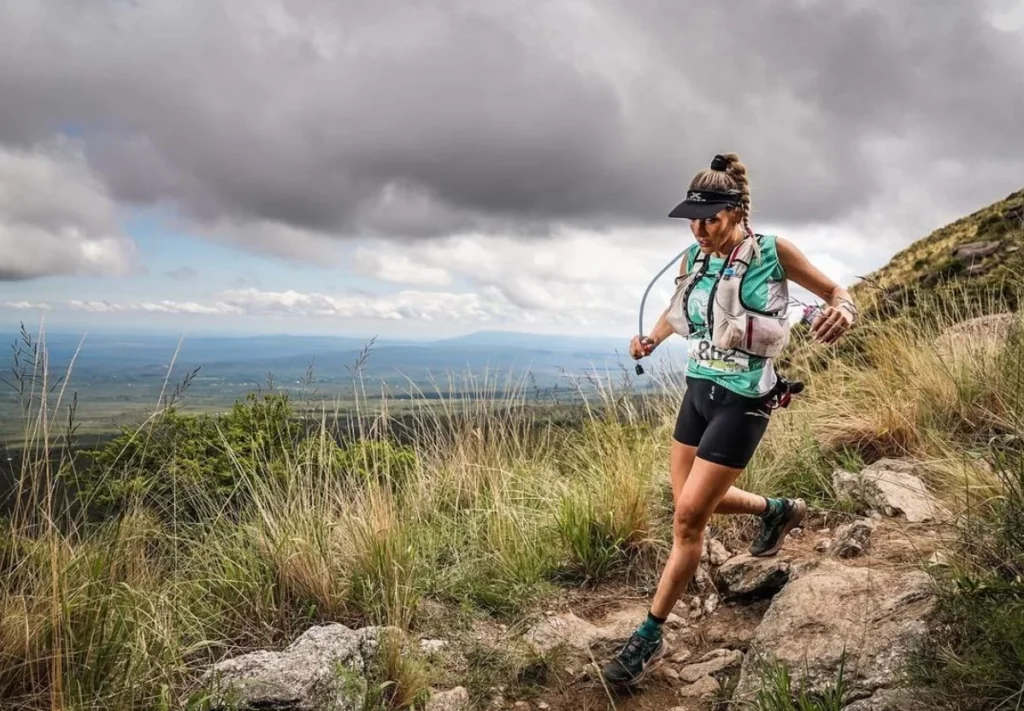
NTRO TAYLOR: At the southern terminus of the Americas lies one of the most beautiful and rugged landscapes that this floating rock has to offer. Few adventurers get the opportunity to go, but a common descriptor is simply “wild.” Patagonia. In the heart of the region is where Weis, a trail-centric running brand, was born and tested. We met Weis at The Running Event last year. They were skeptical of me asking for review products because they wanted to be sure that I wasn’t going to say good things in exchange for gear. They wanted the good, the bad, and the ugly from us to be able to provide the best options for runners. Bad and ugly are terms that you won’t hear in this review. Quality is at the forefront of Weis, and niche brands like it, because they were born out of a sense of dissatisfaction. Honestly, more people should be dissatisfied more often, especially when it leads to top-notch gear like this. WEIS SIMER II 10L VEST TAYLOR: I’ll let our full review do the talking for this one. In short, this is one of the best vests available. The Simer II 10L should be your first stop when the fit is of utmost importance. Even with a full load of bottles, a phone, a jacket, and more, this vest worked its magic to resist bouncing and stay locked in place. Usually, the cost of such security is the equivalent of letting a boa constrictor wrap your rib cage. Not here, as the Simer II employs a second set of security measures. It combines initial chest clip adjustments with some underarm tweaks to hold both the top and bottom of the pack close to the body. No matter how much you move or wiggle, it stays right where you set it. Check the review linked above for more in-depth details on materials and pockets. In short, this vest has quickly become my favorite because of its excellent fit. I’m hoping for a second version to address some storage options (not necessarily issues), but that’s all I have in terms of criticisms. PRICE: $140 WEIS SIMER 1L VEST TAYLOR: We all know the struggle of deciding between a vest or a handheld for a run. There’s just that perfect middle distance where you’re not quite sure. Well, the Simer 1L Vest has been settling that debate for me as of late. It’s a vest, but it’s only big enough for the essentials. You could wear it for shorter runs where you only want the essentials or pick it for a race without too much distance between aid stations. This simply constructed vest has the same up-front options as the other Simer vests, with multiple pouch-style pockets to fit all your goods. What comes in clutch here, again, is the fit. It’s remarkably secure and comfortable because of the multiple adjustment points. Not only do they stretch across the chest, but there are the same clutch adjustments hidden under the arms that bring the bottom side of the vest closer to the body. It’s got zero bounce, even with bottles. What’s different about the 1L vest is that the back doesn’t have a pocket. It’s a vented mesh with two smaller pockets at the lower edge of the vest. These make for a quick and simple stash of items like gloves, a headlamp, or a windbreaker. This is a light and hands-free option for trail and road runners alike. PRICE: $130 500ML HANDHELD SOFT FLASK TAYLOR: The soft-flask handheld seems to be the most convenient piece of gear in the Weis lineup. It combines a good-sized flask with a little burst of storage in an easy-to-hold package. Even the mesh handgrip is comfortable for long miles. However, I had a few issues with the lack of overall structure. The soft approach was a bit too floppy for me to hold it securely, and it became more of a nuisance as I emptied the bottle. I know it’s a common complaint for similar handhelds, but it didn’t quite work for me. PRICE: $35 SLIM FANNY PACK TAYLOR: Clip, zip, and go! The Weis Slim Fanny Pack was the piece of gear I overlooked the most but ended up using a ton — funny how that happens. This has been a go-to piece of gear this fall. I grab it for every trail run because of the comfort and security. Once clipped on and placed, I don’t even recognize it’s there. I have a couple of other waist belts too, but this one is the least cumbersome. It’ll easily hold a phone and a set of keys (but not much more). Like their vests, this one had zero bounce for me until I had three or four items in the pocket, which I knew would be overloading the system a little. The easily adjustable strap lets you place the belt where you want it rather than having it slide up or down (my experience with other belts). I simply set it around the waistline of my shorts, and it stays. The Slim Fanny Pack also works well for a third hand in the grocery store post-run. Just saying. PRICE: $37 Z-COMPACT VARIO COMPOSITE X2 CARBON LITE POLES TAYLOR: Poles have a unique place in my quiver of trail running tools. Since they’re one of those few and far-between items that I only bring for specific terrain and efforts, I’m particular about what I like. Chances are, you’re the same. For starters, I think this particular set would be great for trekking but only alright for running. They’re easily packable and made of carbon fiber, but they’re still on the heftier side when put against the competition. It’s not a massive weight difference, but it could be enough to sway you with something as light as a pair of poles. Other than that, the Z-Compact poles are some of the most durable I’ve ever used. The carbon fiber is impressive and handles wear and tear better than others. I don’t worry even a little bit
Ciele Elite Collection is the Elevation of Running Apparel

INTRO On race day, you want to race, not just run. In any other sport, race day means employing the lightest and most technologically-developed products. Think carbon-fiber components and aerodynamic designs for race cars and bicycles. But when it comes to running, we throw on the most expensive chassis and wheels, but tend to just put on whatever looks good when it comes to the body. Ciele Athletics is looking to fix that with its all-new Elite Collection, an apparel drop of five pieces designed to give athletes the most of their performance on race day. For a brand known primarily for its top-tier running caps (we can confirm, they’re pretty much the best), a foray into premium run apparel may seem like a bit of a leap. There’s quite a bit of difference between a hat and a singlet or jacket, especially when that gear falls anywhere between the $100-$400 range. However, when Ciele went into the research and development of the Elite Collection, they did so with intentionality throughout every step of the process. Their goal with the Elite was to find “the very best recycled fabrics, the very best factories, the very best constructions and use these ingredients to build the very best products for your run.” The standard was impeccably high from the start. Keep in mind that when they first debuted, Ciele caps were twice the price of almost every other running hat out there. Now, they’ve become the standard that many running hat companies are trying to emulate/match, though few have come close. And so it is with the Elite Collection, with features unlike any we’ve seen in other running apparel. As you’ll see, the thoughtfulness is apparent, from the welded pocket seams of the DBSShort to the unbelievably light weight of the waterproof FLRJacket. For the jacket in particular, there were only a handful of factories globally who could produce it. Ciele chose a factory that they had been to, and know the team personally, in order to produce a garment that would meet the high standards we were driving for. Is this gear for everyone? Certainly not. The price alone is a barrier for most runners. But for those that can afford it and are looking for a product that features recycled products made in premium factories and with thorough regards to performance engineering, then the Elite Collection is surely something to consider. Learn more about the pieces below and our experience running in them. RCDSINGLET ELITE Made from recycled fabric yarns, this singlet tingles the senses by truly allowing you to feel like an elite. In a nothing-there manner, the stitchless construction is comprised of Ciele’s COOLmatic.EXP knit, which is– get this– infused with carbon fiber. I didn’t even know this, but carbon fiber absorbs odors and allows for greater breathability and temperature regulation. And because of this superior construction, the performance won’t fade or wash out, unlike traditional fibers. It still maintains high stretch and durability but retains a sturdy-yet-soft feel. The singlet also employs airBEAM, which is specially designed vents on the spine to allow the body to perform its natural cooling process. A constant two-way air exchange pushes warm air our and circulates fresh air. I can confirm that on the run, this singlet truly does feel weightless and reminded me of the best elite singlets I’ve somehow scammed companies to let me wear on race day. Chafing is non-existent and the breathability is as good as it can get. The carbon fiber construction is something I’ve never seen before; basically, I’m excited to keep this on the “good side” of my singlet drawer for a long time. PRICE: $100 RCDTSHIRT ELITE The RCDTshirt elite is essentially the same construction and materials as the singlet, just in t-shirt form. If you want all the details, scroll up just a bit, but the idea here is that you’re getting a bit more protection and coverage for less-than-singlet weather. Did we also mention this has a lifetime guarantee? Bold move for a running t-shirt, but we like it. PRICE: $120 QCKBRA ELITE This running bra features an OekoTex approved fabric featuring 65% recycled nylon with 35% elastane for shape retention and support over any distance. It also features all of Ciele’s most advanced apparel tech, including COOLmatic.plus lining and HeiQ Smart Temp® for accelerated wicking and HeiQ Fresh® for odour control. Meanwhile, eflective elements keep you lit from sun down to sun up. includes removable pads. PRICE: $60 DBSSHORT ELITE For us, this is the highlight of the collection. Another garment that features the carbon-infused yarn of the COOLmatic.EXP, the shorts are everything you need on race day. It’s also made from stitchless construction, which is… wild. But again, it comes with Ciele’s million miles guarantee, so we’re not worried about it. Waistbands are always an issue with running shorts, but this one is next-level good. Super soft to the touch, it features odor control and stowaway adjustment cords. Clearly some thoughtful design was put into this short. Which is evidenced even further by the front panels, which use a durable water repellent finish that’s helpful on damp days with headwinds. But here’s the best part– the shorts feature the best fuel pockets we’ve ever seen in a short. Three mesh inner fuel pockets are flat-welded to the short so you are locked and loaded on race day. Speaking of race day, the 3-inch split style allows room for your entire range of motion so the short feels like it isn’t there. Look down every so often just to make sure. PRICE: $120 EVDSHORT ELITE This one is probably our least favorite of the collection, because we kind of don’t know where it exists? To their credit, Ciele does note that it’s designed for running and in-between runs (i.e. a casual short over your race tight that feels just right on a community run). The dual button system on the sides is interesting, allowing for customizable levels of mobility, but we’re also not sure where we would actually use
Saucony Triumph 20 Review: Not an Endorphin, But a Triumph
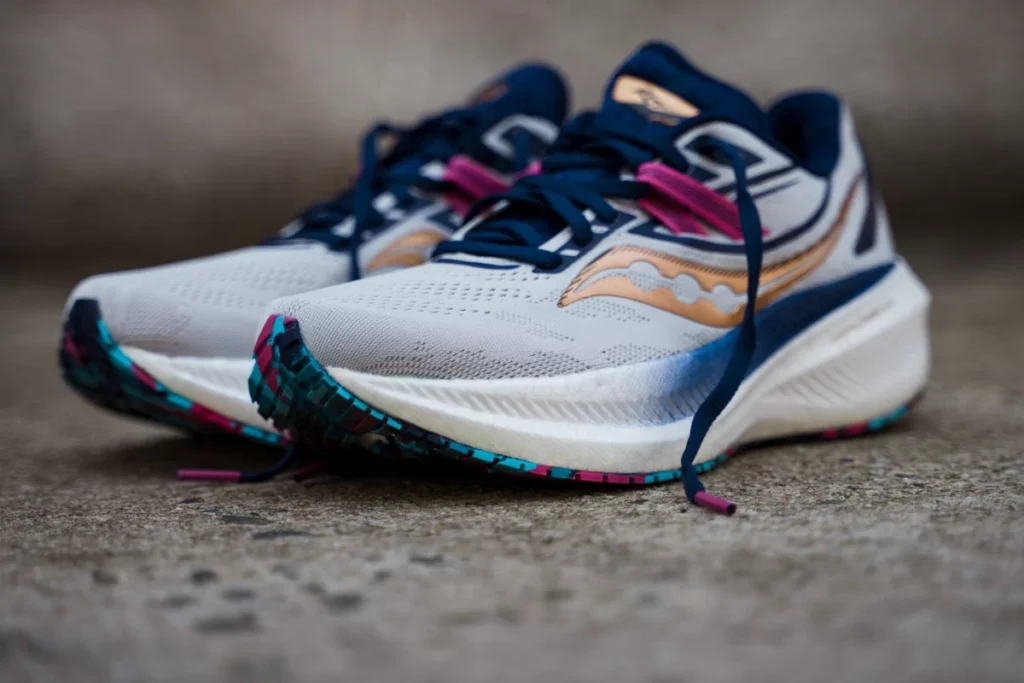
INTRO MEAGHAN: Saucony has been dropping some gems this year. The refreshed Endorphin line is the crown jewel, so why not expect more greatness across the board? It’s been a couple of years since I laced up a version of the Triumph, but I’m always down to test out a highly cushioned trainer. Bring on the Saucony Triumph 20. This year’s model comes with a brand new slab of PwrRun+ that’s lighter and softer than its predecessor. Oh, and Saucony bumped the stack height from 32 to 37mm in the heel and 24 to 27 in the forefoot. That means more stack and a higher drop, somehow in a lighter package. The upper is all-new, too, but it still brings the same plush comfort that Triumph fans know and love. Saucony’s lacing system offers some additional lockdown features at the eyelets, and there’s no shortage of padding in the tongue and collar. On paper, this shoe checks all the boxes. But how does it feel out on the roads? ADRIENNE: Meg is right. Saucony has been killing it this year. My personal history with the Triumph starts back at version 17 when Saucony introduced PwrRun+ to the equation. I expected a heavy and dull shoe back in the day, and I was happy to be wrong. That was then, and this is now, so let’s see if Saucony has kept up its winning ways in the Triumph 20. Once again, Meg is right — the Triumph 20 passes the eye test with flying colors. I don’t even mind wearing the shoe in public, which doesn’t always happen with running shoes. It’s as comfortable as it is stylish, so you know you’re in for a plush ride. For most people, the FormFit design will hold your foot in place and adapt to you rather than forcing you to change your stride for the shoe. I put almost 50 miles on the Triumph 20, and it shines best as a recovery/easy day shoe. It’s capable of picking up the pace, but there are better options — even within the Saucony stable. The slower I went, the better the shoe felt, and for me, on days where I need not push, this turned out to be a good thing. Be warned, however, that the Triumph isn’t an Endorphin in disguise. It knows what it is and leaves the high-tech cruisers in their own lane. Let’s see what I mean. RYAN: I’ve had my feet in more than my fair share of Saucony shoes this year, and I’ve yet to find one I didn’t like. I trotted in the Tempus, felt good in the Freedom, did something that starts with A in the Axon, and thoroughly enjoyed the Endorphin Pro and Speed. Now it’s time to take it home in the Triumph. Sometimes a shoe happens to land at the perfect time. I’m about a month out from my first marathon at this point, and I’m looking for as much cush as possible to hold me through the heap of road miles. That’s basically what the Triumph 20 is — a fat stack o’ foam with a plush layer of cushion on top. There’s no reason this shoe should be as light as it is, but that’s magic, baby. Meg and Adrienne covered most of the important stuff above, and they touch on the important tech specs below, so I’m just gonna pass along the vibes. Let’s roll. THE GOOD MEAGHAN: Let’s start with the aesthetics because I love what Saucony did here. The Triumph 20 colorway I received (Prospect/Glass) is a neutral gray with some bright accents like a shiny gold Saucony logo. It’s fun without being over the top. The PWRRUN+ sock liner and cushioning underfoot feel great upon step-in. Paired with the highly padded tongue and collar, it’s got all the features of a very plush shoe. While Saucony increased the stack, they also reduced the weight. My US W7.5 came in at 8.3oz — pretty decent for a well-cushioned trainer. ADRIENNE: I agree with Meg that the weight reduction was nice, and the step-in felt luxurious. I have relatively narrow, low-volume feet and had no problems with the fit. I was able to lace up and go without a second thought. If you love hella cush, then you’ll probably love this shoe. There’s cushioning for days with the PwrRun+, and it’s not interrupted by a plate, a different core, or any other midsole modification. The change means there’s less fire in the Triumph 20, but that’s by design. I found the ride pretty smooth overall, though there are some things I’d change (more on that in a sec). It’s not so much a snap and a pop as a slow, luxurious roll. Think Rolls Royce, not Ferrari. As I ramp up my fall training, I need a go-to recovery shoe for the double days when my legs are tired. The Triumph is that shoe — it’s soft and comfortable, and it keeps me from wanting to push too hard. It also feels stable and grips the pavement well, thanks to subtle outsole improvements. There’s more than enough rubber here. In my opinion, this is one of the most comfortable trainers of the year. I didn’t run into hotspots, irritation, or anything else that made running less enjoyable. The materials are premium, and the cush is king. It reminds me of the recently reviewed Mizuno Wave Neo Ultra in some ways, which is actually a compliment. RYAN: Comfort, comfort, comfort. That’s the story of the Triumph 20. There’s padding everywhere, from the extra-thick midsole to the marshmallow-esque upper. Everything is thick, and it feels great on foot. I took the Triumph for 12 miles right out of the box and enjoyed every one of them. Then, I took it for a 17-mile long run with similar results. Speed didn’t matter for either effort, just comfort and distance. The PwrRun+ is plush underfoot, and it doesn’t feel like it deadens out over the course of a run. No, it doesn’t add anything incredible, but I
Recipes from Meghann Featherstun: Let Go My Waffles
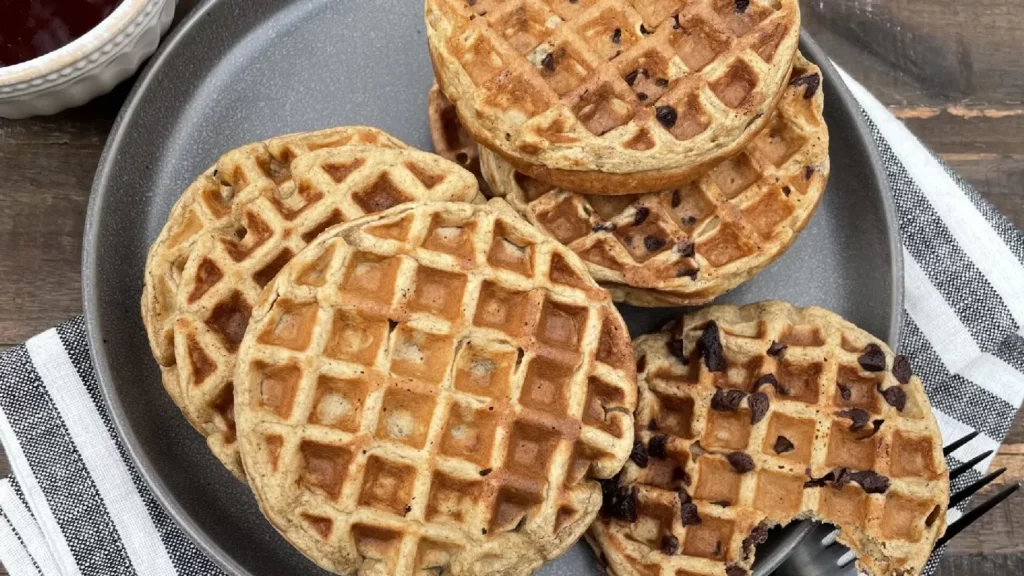
LET GO MY WAFFLES Where our morning runners at?! Don’t miss that opportunity to refuel when you get home with something warm & delicious, and it might provide some solid nutrition as well. Careful or someone might steal one of these bad boys… INGREDIENTS DIRECTIONS Pro tip: double this recipe if you’re feeding a crew. Nutrition Facts: 1 waffle (makes 5 waffles) 140 calories, 6 gm fat, 19 gm carbohydrates, 5 gm protein ABOUT MEGHANN Meghann Featherstun is a sports dietitian who works with runners all over the country to help them fuel their bodies for the best performance in life, running, and beyond. Check out more recipes, blog posts, group nutrition programs, and 1-on-1 nutrition coaching from Meghann at featherstonenutrition.com or on Instagram.
Air Relax Pro Recovery Boots Review: Under Pressure (The Good Kind)
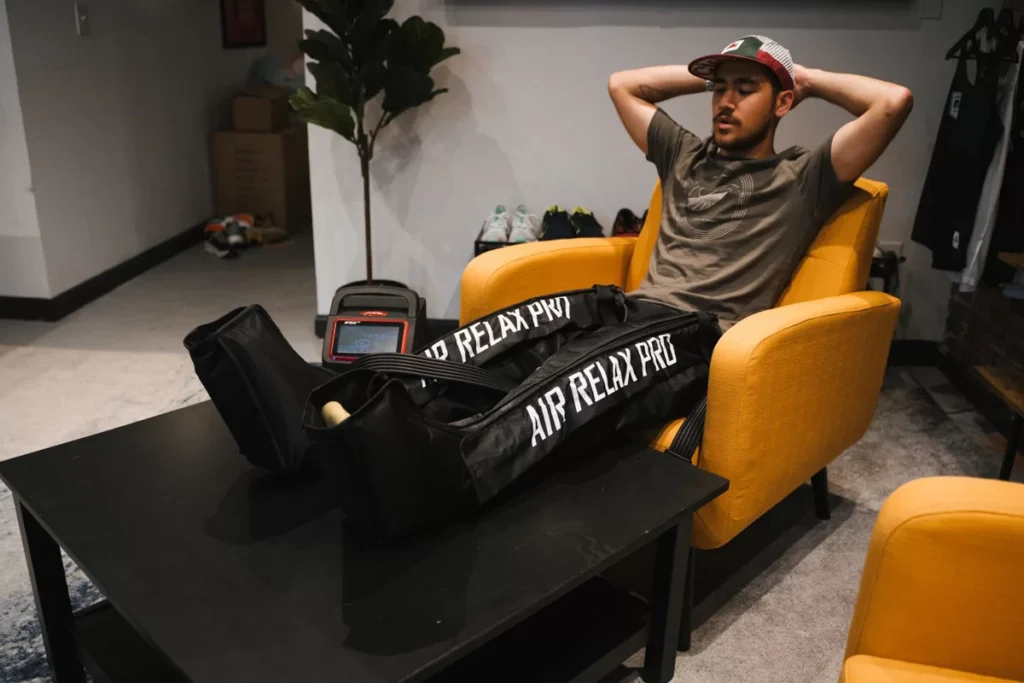
INTRO BRANDON: If you’ve been in the running world long enough, somebody somewhere has told you that recovery is the key to a more successful and sustainable running career. They’re not wrong, recovery is more important than most of us give it credit for. There are tons of studies that prove it, too, lending legitimacy to everything from a foam roller to an ice bath. Companies are getting in on the sky-high demand for recovery products, and I get to try them out. I was pretty stoked to find out that the Air Relax Pro Recovery Boots were on their way to me. Before I get into the nitty-gritty, at least promise me you’ll take this one piece of advice: There will never be a better recovery system than a good night’s sleep and proper nutrition. Alright, on to it. Air Relax is a recovery company that prides itself on developing state-of-the-art technology to improve muscle and circulatory recovery. They sent me their AR-4.0 Recovery System to try out, complete with all the bells and whistles. The system comes with an AR-4.0 Control Unit, the leg sleeves, hose bundle, AC power supply, and a large 38L carrying case and power bank for life on the go. Fair warning, the complete set tips the scales (or burns your wallet) to the tune of $1,250. It’s not exactly cheap, but how do you put a price on your health? THE GOOD BRANDON: Let’s break it down, piece by piece, starting with the boots and the AR-4.0 Recovery System. The boots strap nicely around each bag and are comprised of six compression chambers. It might sound like a lot of sections, but they’re meant to replicate a more anatomically accurate human leg — tighter in some places, looser in others. The design is slick, with uncompromisingly strong zippers and durable nylon fabric to help the chambers expand and contract. All I’m trying to say is that you won’t have to worry about breaking a zipper or popping a chamber… ever. The AR-4.0 Recovery System is fancier than most interfaces in cars, with a 5.5-inch LCD built-in. It allowed me to customize my recovery experience with 14 levels of pressure, customizable chamber selection, and various recovery plans. An optional power bank can provide you with three extra hours of juice while away from a wall socket. The 38L carrying case is small enough to fit as a carry-on yet big enough to fit all of the items mentioned above with room left over for a day or two’s worth of clothing, making it an ideal traveling companion. I can sum it up by saying you’ll have a pretty amazing recovery experience. Oh, and the entire process is pretty quiet, which is nice if you want to throw on the Air Relax Pro boots while you catch up on House of the Dragon. I’ve been using them for a week straight, and I don’t see myself breaking that streak. THE BAD BRANDON: The obvious elephant in the room is that all in, you can end up dropping $1,250 for the Air Relax Pro with all of the bells and whistles. If you want to save a little cash, you can grab a smaller, less customizable setup for around $575. It’s still not cheap, but it’s a little better. I like the idea of Air Relax’s optional power bank and carrying case, but they could have been better executed. The case adds little more than a way to keep things organized, and I mostly use the boots at home. That goes hand in hand with not needing the power bank, as there are more than enough outlets around my house. I’m sure some people will like the added portability, but the entire package isn’t all that light, so I won’t be lugging it around. AIR RELAX PRO RECOVERY BOOTS CONCLUSION BRANDON: The Air Relax Pro AR-4.0 Leg Recovery System is amazing, but it can be a tough sell at $1,250. That’s a lot of money, especially compared to other recovery alternatives like rollers and ice baths. However, the Air Relax Pro is a safe bet if you are looking for a top-notch leg recovery system. You can customize your preference of boots, sleeves, and systems for a full-body experience — at a price. Since bringing the Air Relax Pro into my life, I’ve noticed a major shift in my recovery and overall wellness. My legs feel less tired and more ready to go on hard workout days — even as marathon season arrives. As I mentioned earlier, sleep and nutrition are still my one and two, but this AR-4.0 system is a powerful number three. You can pick up the Air Relax Pro Recovery Boots for $1,250
Recipes from Meghann Featherstun: Bagel ‘Winter Bites’
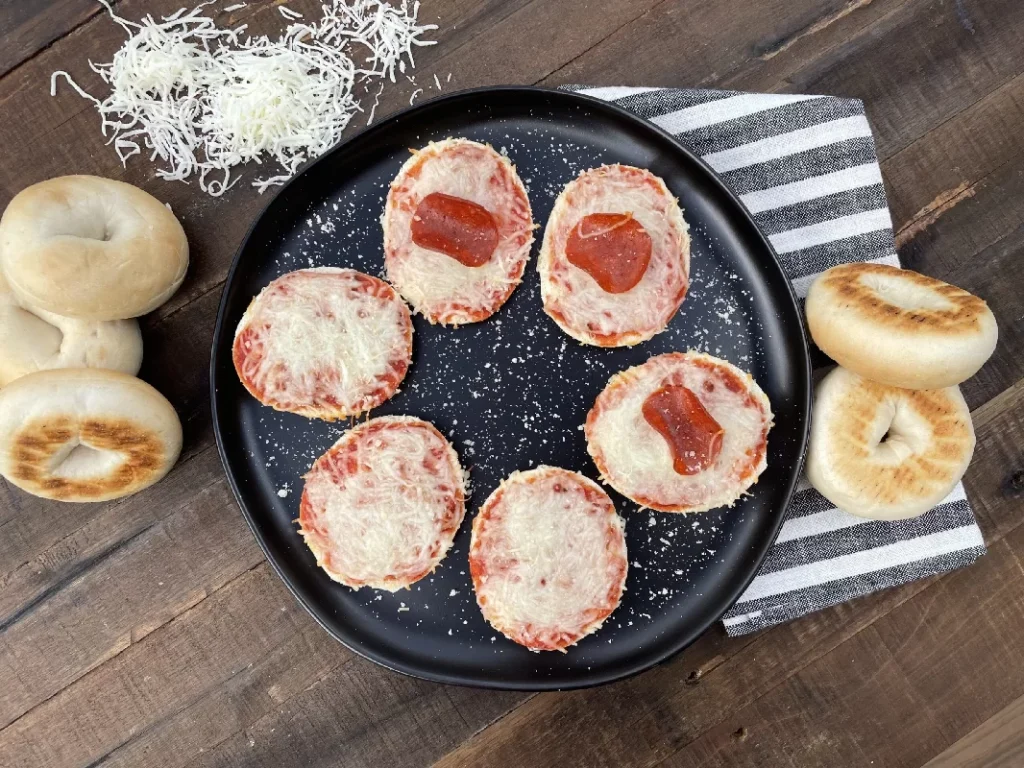
BAGEL ‘WINTER BITES’ Feeling like winter running bites the big one?! You’re not alone. Get out there and get those miles in and have all the fixings for some nostalgic bagel bites waiting for you when you get home. Get creative here, folks. Whatever you like on your pizza is fair game! INGREDIENTS DIRECTIONS Nutrition Facts: 4 bagel bites (1 recipe) 350 calories, 8 gm fat, 55 gm carbohydrates, 14 gm protein ABOUT MEGHANN Meghann Featherstun is a sports dietitian who works with runners all over the country to help them fuel their bodies for the best performance in life, running, and beyond. Check out more recipes, blog posts, group nutrition programs, and 1-on-1 nutrition coaching from Meghann at featherstonenutrition.com or on Instagram.
Recipes from Meghann Featherstun: DunkaRUN Dip
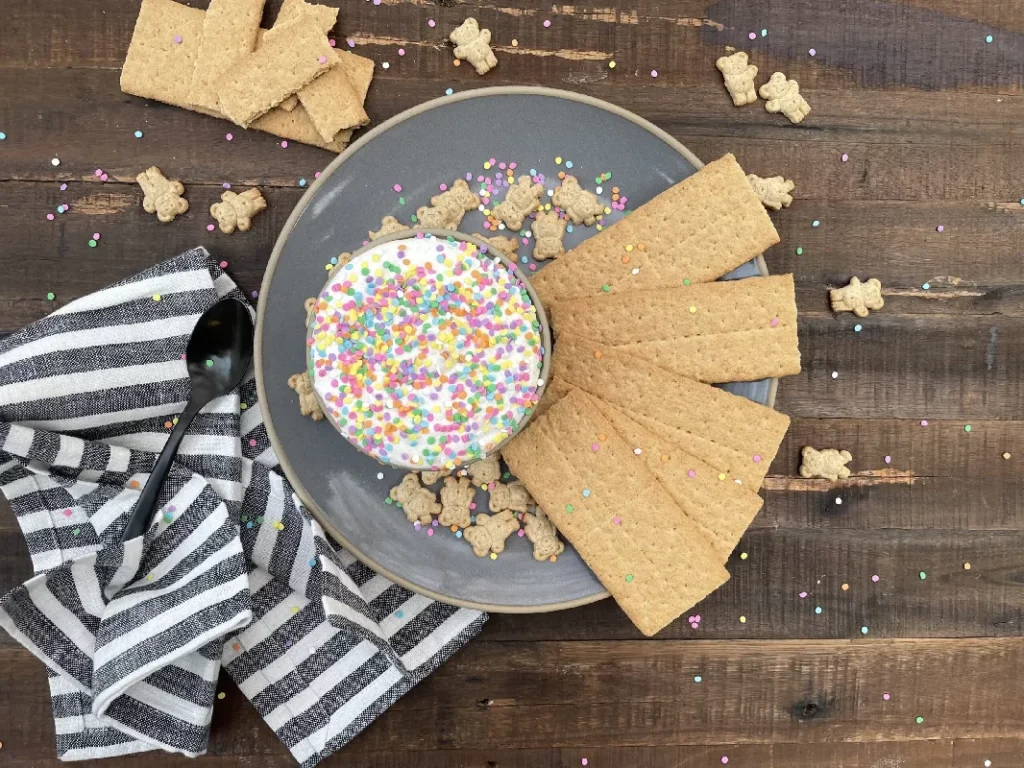
DUNKARUN DIP Who says we can’t have a little fun with our nutrition?! Those icing + cookie packs we all tried to trade our entire lunch for at the elementary school lunch tables are back in a slightly healthified way, but we promise you won’t mind. Delicious. Fun. And, dare we say, dip those pre-run graham crackers straight into this DunkaRUN dip and watch yourself crush some runs. INGREDIENTS DIRECTIONS Nutrition Facts: ¼ cup (15 servings total) 60 calories, 2 gm fat, 10 gm carbs, 1 gm protein ABOUT MEGHANN Meghann Featherstun is a sports dietitian who works with runners all over the country to help them fuel their bodies for the best performance in life, running, and beyond. Check out more recipes, blog posts, group nutrition programs, and 1-on-1 nutrition coaching from Meghann at featherstonenutrition.com or on Instagram.
Lumen Nutrition Review

WHAT YOU NEED TO KNOW MEAGHAN: I first heard of the Lumen in 2020 when an ad for the device popped up in my news feed. It claims to be the first hand-held device that enables you to “hack” your metabolism. I had just started working with a sports dietician (Meghann Featherstun) and asked her if I should try and get a unit for review. She did some research and suggested we hold out while I was in the middle of training for a marathon PR. Fast forward to October of 2021, and the company reached out to see if we wanted to try it. I figured why not. So, what exactly does this vape-looking device do? Let’s dive in. Lumen is a small breathalyzer equipped with Bluetooth that syncs to an app on your phone. It measures CO2 levels to decipher whether you’re running on carbs or fat and aims to help improve ‘metabolic flexibility.’ Each time you breathe into it, the device analyzes your breath, giving you a score from 1 to 5 to tell you whether your body is running on fat (a 1 or 2), carbohydrates (a 4 or 5), or a combination of both (a 3). It follows with a recommended meal plan of approximately how many carbs, fat, and protein servings you should be eating that day, with the ultimate goal of making your metabolism more efficient. THE GOOD MEAGHAN: Using the Lumen properly means you are starting your day with this thing every morning. Before you even have a sip of coffee, you need to breathe into the device to get an accurate reading. The biggest benefit here? Starting your day with a couple of nice, deep breaths. The worst part? If you don’t score a 1 or 2, you kinda feel like a failure. Since the overall goal is to help you become ‘metabolically flexible,’ the idea is that you want to start your day (after fasting) burning fat, then switch to burning carbs throughout the day. Why? According to Lumen, increasing our metabolic flexibility can have multiple positive effects, like a stronger immune system, sustained energy, fewer blood sugar roller coasters, and overall better health. In addition to testing your breath every morning, you’re also encouraged to use the device before and after meals and exercise and right before bed. The more effort you put into using the device, the more data and information you’ll get in return. After a couple of weeks of using the device, you get a metabolic flexibility score. I scored somewhere right in the middle: not inflexible, but not super flexible. So how do they recommend you increase your metabolic flexibility? Mainly through nutrition, fasting, and exercise.Lumen weekly recapLumen nutrition planLumen levels breakdown THE BAD MEAGHAN: While this all makes sense, I have to think back to all of the conversations I’ve had with my sports dietician. What is my #1 goal? Is it to be metabolically flexible? Or is it to perform at my best? As someone who is always pretty active, I rarely have ‘low carb’ days. If I were following the guidance of this device, I would be eating half, sometimes less than half, of the carbs that’s been recommended by my sports dietician. While this might help me wake up in a state of fat burning, it likely won’t help with performance. On the flip side, I can see how this device might be helpful to someone deciding if they need to fuel before a run. A quick breath into Lumen pre-workout will let you know if you’re good to get you through your session or if a snack is in order. LUMEN NUTRITION CONCLUSION MEAGHAN: As a pretty big data nerd, I’ve enjoyed testing out the Lumen. It’s been fun to find out if I’m burning fat or carbs in real-time, and there’s a wealth of information within the App, from nutrition basics to recipe suggestions broken down by macros. The Lumen comes at varying prices depending upon the program you choose. On the lower end, the device with 6 months of use will cost $249. On the higher end, the device with 18 months of use will cost you $349. If you’re interested to learn more about your fat/carb burning state without going to see a professional for testing, this is an ideal device. While I would be hesitant to recommend this to an athlete in the middle of a hard training block, I think the information the device provides could be beneficial to just about anyone.
